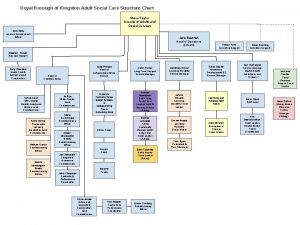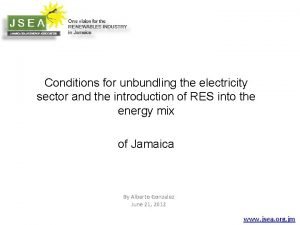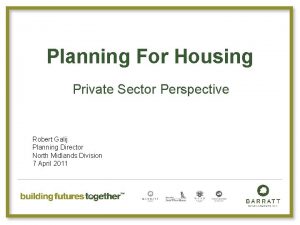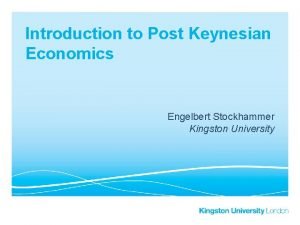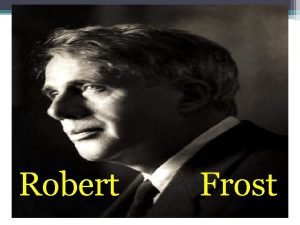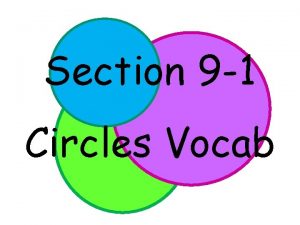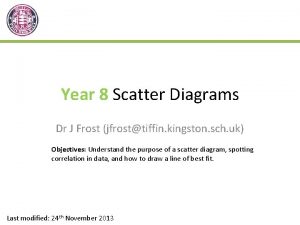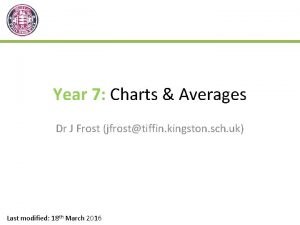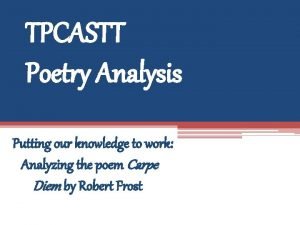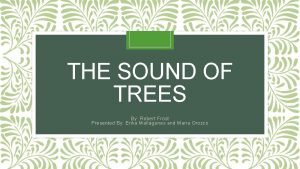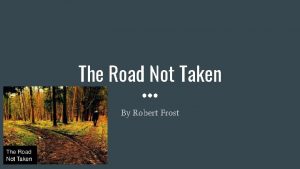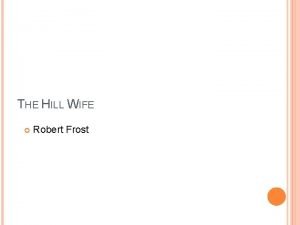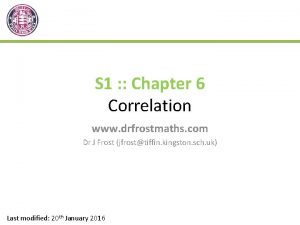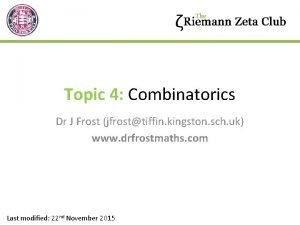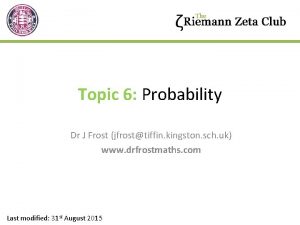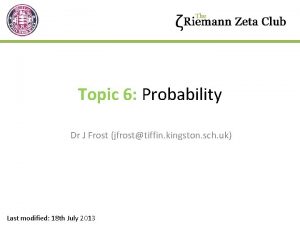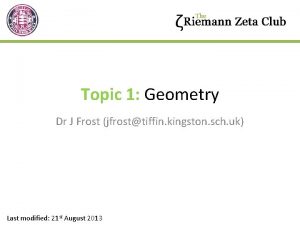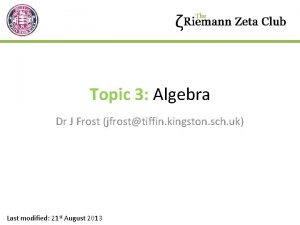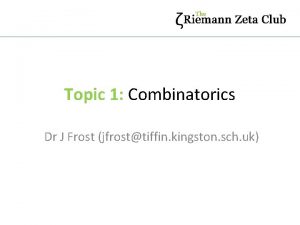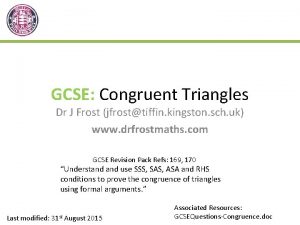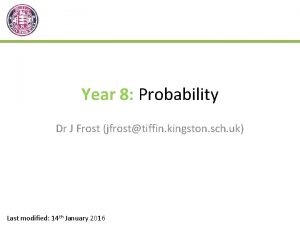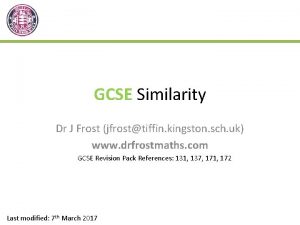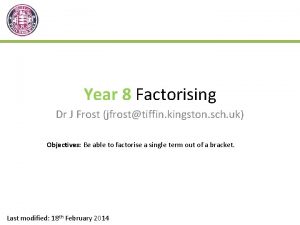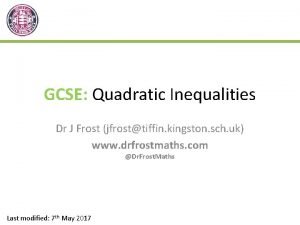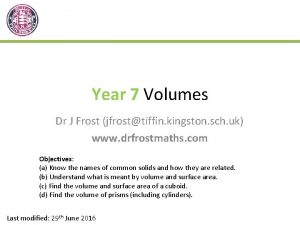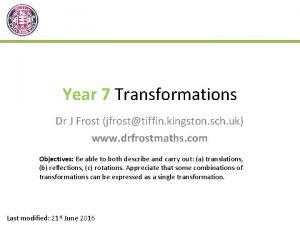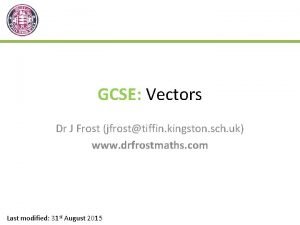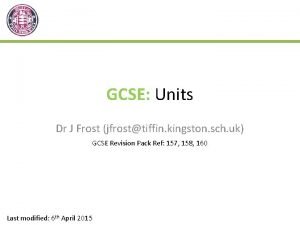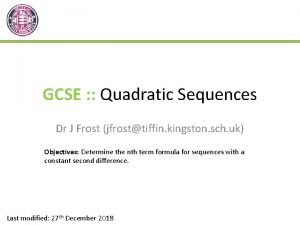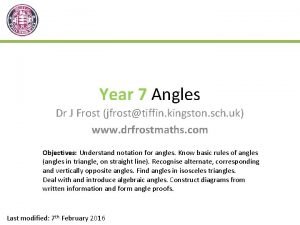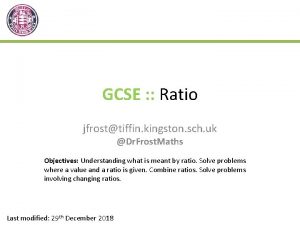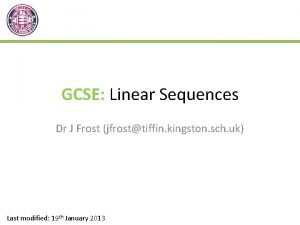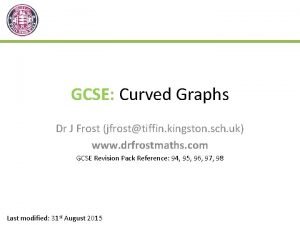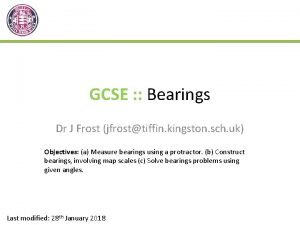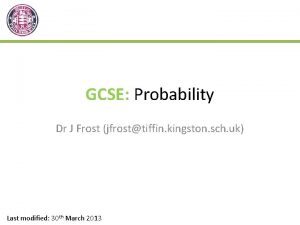Topic 0 Introduction Dr J Frost jfrosttiffin kingston




























- Slides: 28

Topic 0: Introduction Dr J Frost (jfrost@tiffin. kingston. sch. uk) www. drfrostmaths. com Last modified: 31 st August 2015

Slide Guidance ? Any box with a ? can be clicked to reveal the answer (this works particularly well with interactive whiteboards!). Make sure you’re viewing the slides in slideshow mode. For multiple choice questions (e. g. SMC), click your choice to reveal the answer (try below!) Question: The capital of Spain is: A: London B: Paris C: Madrid

What and who this club is for What we’ll concentrate on • • • Senior Maths Challenge British Maths Olympiad MAT A little bit of STEP Giving a general broad grounding of maths to help with university interviews, etc. What this is not… This is not intended to help you get an A* at A Level or supplement the content you do in your usual classes. Much of what we’ll cover (elementary number theory, combinatorics, functional equations) will likely be completely new topics to you. Who this is for • People who enjoy maths who want to explore the more interesting aspects outside of the A Level curriculum. • People who want to do well in the SMC/BMO. • People who are considering entry for a maths-related degree at a competitive university (particularly Oxbridge). • I don’t presume people are doing Further Maths.

Format/Admin • Please ensure you put your name, email address and school on the sign up sheet before you go. • Please turn up on time! • Most sessions you will be given a problem sheet to take home with you. You’ll be emailed solutions the day before the next session. It’s your responsibility to look through these solutions; we won’t be going over them in the sessions (although you’re welcome to ask me questions on them) • While these won’t be marked, please put as much effort into them as possible – it doesn’t matter if you can’t answer all the questions. ‘Doing problems’ is the most effective way of appreciating the content we’ve covered. To keep organised, you should put together a folder with dividers. Appropriate headings could be: 1. Geometry 2. Number Theory 3. Algebra 4. Combinatorics 5. Graphs 6. Prob/Stats 7. Functional Equations 8. Logic 9. Pigeonhole Principle 10. MAT 11. Other

Website www. drfrostmaths. com/rzc All slides, problem sheets, solutions and other supplementary materials will be put on this website. Some topic slides will have an ‘Epilogue’ at the end: slides we won’t have time to go through in these sessions, but are available for you to view online.

MAT • This is the Oxford ‘Maths Admissions Test’. • Up until 2013, was used exclusively by Oxford for those applying for Maths (and joint courses) or Computer Science (and joint courses). • Imperial College now use it for maths applicants. • 2. 5 hour (non-calculator) test. 40% of marks from multiple choice questions, 60% from longer questions. • Based on the C 1 and C 2 A Level Maths modules. But these aren’t just ‘harder A Level questions’: they require a degree more ingenuity and dexterity. • But it is the kind of test you can prepare for to some extent, and we’ll explore some tips and theory useful for these papers later in the year. • At Oxford, a mark of roughly 50% required to be invited to interview, and the average mark of a successful applicant is about 75%.

British Maths Olympiad • A 3 ½ hour paper consisting of just 6 questions. • You’re invited to take it if you’re in roughly the top 1300 scorers in the Senior Maths Challenge (in 2012, you needed a score of 93 out of 125 – this corresponded to getting 17 out of 25 questions right) • These questions are very difficult and the challenge is often knowing where to start. Many of the questions however become more approachable if you’ve had prior exposure to questions on a similar topic. • Some questions are more ‘routine’ if you know the typical strategies. Others require a novel idea that might not be obvious to think up. • There’s a ‘Distinction’ award if you’re within the top 25% of people taking the test. • The top 100 are awarded prizes, and most of these people are invited to ‘BMO Round 2’. A small handful of these are subsequently selected for the national team to compete in the International Maths Olympiad.

Senior Maths Challenge/BMO • The Senior Maths Challenge is on November 7 th 2013. • Hence we’ll start with the topics that will be most useful for this test: Geometry, Number Theory and Algebra. • The BMO is shortly after. SMC Topics Probability 2% Other 9% Number Theory 19% Algebra 20% Geometry 50% This was the makeup of ‘harder’ questions (Q 16 -25) on the SMC papers from 2004 -2012. It goes without saying that you should concentrate your efforts on Geometry!

STEP • • • This exam paper is used as an offer requirement for Cambridge and Warwick mathematics courses. In contrast to MAT, you would take this in the summer of Year 13, not prior to your university interview. The paper is 3 hours. You have to choose 6 of the 13 questions (8 pure, 3 mechanics, 2 probability and statistics). STEP paper questions are in some ways just ‘hard A Level questions’. But they differ in a few ways: • They are less guided than A Level questions. e. g. You might have to integrate by an appropriate substitution: in an A Level exam they would give you the substitution, in a STEP paper they wouldn’t. • They require a good deal more technical dexterity – you can’t afford to be sloppy in your maths. Contrary to some people’s perceptions, STEP II and STEP III are of comparable difficulty (and indeed a similar distribution of people get the S, 1, 2 grades in each). It’s just that later STEP papers are based on material later into the Maths/Further Maths A Level syllabus. In contrast, MAT and BMO doesn’t really require any knowledge beyond C 1 and C 2.

Different exams BMO Difficulty STEP MAT (This is a very rough judgement!) A Level The extent to which the style of question deviate from A Level ones.

Topics we’ll cover across the year Geometry Probability/Stats e. g. What is the maximum number of the following statements that can be true? … Number Theory e. g. “How many multiples of 2013 have 2013 factors? ” Algebra Combinatorics Graph Sketching/Reasoning Logic Functional Equations Pigeonhole Principle e. g. A cinema sells 31 tickets in total one evening, and each movie can be watched by up to 3 people. Show that the minimum number of movies seen by the same number of people is 6. MAT Prep

ζ Introduction Set Notation Here, we cover some basic set notation and common sets used to represent collections of objects (usually numbers).

What is a set? A set is a collection of items (often numbers) with two properties: 1. It can’t contain duplicates. ? doesn’t matter. 2. The order of the items ? False True False True (Click to vote!) This is like asking “in a bag containing balls labelled 1 and 2, do we have within this bag another bag containing a 1? ” No we don’t!

Infinite Sets Some sets are infinite in size. Some are so common we use special symbols to represent them: Symbol Name ? ? ? Real numbers ? Includes all numbers which can’t be expressed as fractions. Complex numbers ?

Infinite Sets Click to boxes to move them to the correct set in this Venn Diagram. 3. 4 4 -3

Infinite Sets Set notation is particularly useful when talking about functions: ?

ζ Introduction Proof We look at what constitutes a ‘proof’, when a proof might be incomplete, and the different types of proof often available.

When a proof is not a proof ? ?

Counterexamples Source: MAT A B C D

What’s wrong with these proofs? BMO 1 Edwina: Bob: “Each row can have up to 4 counters in it. There’s 8 rows, so clearly we can’t have more than 32 counters. ” She’s given an upper bound for the maximum (i. e. that the maximum can’t be more than 32), but hasn’t actually shown we give an arrangement of 32 counters? which satisfies the conditions. For all we know, it’s not possible to do it with 32 counters. Bob simply draws a valid arrangement using 32 counters (and let’s say he’s right: the maximum is indeed 32 counters) He hasn’t justified that we can’t have more than 32 counters. This is easy to show, but needs to be? explicitly stated.

What’s wrong with these proofs? BMO 1 Dave: ?

Proof by contradiction In general, to prove a statement by contradiction, we… assume the statement is false, and show ? this leads to a contradiction. ?

Proof by contradiction BMO 1 ?

Two-way proofs BMO 1 Sheila: ? Proofs needed: X is true if, and only if, Y is true. ?

ζ Introduction Epilogue: Proof by Induction (‘Epilogue’ slides are not covered in class)

Proof by Induction This is known as the base case. This is known as the inductive step.

Proof by Induction ? ?

Proof by Induction There’s a slight variant of proof by induction which you WON’T see in FP 1: (there’s another good example in the Functional Equations slides) Example: Prove that every positive integer greater than one has at least 1 prime divisor. ? ?
 Aquajet kingston
Aquajet kingston Adult social care kingston
Adult social care kingston Kingston road traffic
Kingston road traffic Professor margaret kingston
Professor margaret kingston Jps ecommerce kingston 5
Jps ecommerce kingston 5 Prawy hals pierwszeństwo
Prawy hals pierwszeństwo Tom hong
Tom hong Martin kingston qc
Martin kingston qc Kingston strategic partnership
Kingston strategic partnership Engelbert stockhammer
Engelbert stockhammer Kingston planning scheme
Kingston planning scheme Broad and specific topic examples
Broad and specific topic examples /topic/ down
/topic/ down Robert lee frost introduction
Robert lee frost introduction 9-2 tangents
9-2 tangents Intro paragraph outline
Intro paragraph outline Frost i jord
Frost i jord Dr j frost
Dr j frost Dr frost pie charts
Dr frost pie charts Esrt page 6
Esrt page 6 Frost wedging drawing
Frost wedging drawing Tpcastt poem
Tpcastt poem Nothing gold can stay
Nothing gold can stay What was there on the tree
What was there on the tree The road not taken presentation
The road not taken presentation Robert frost legacy
Robert frost legacy The hill wife
The hill wife Weinstein frost regimen
Weinstein frost regimen Www.drfrostmaths.com
Www.drfrostmaths.com

